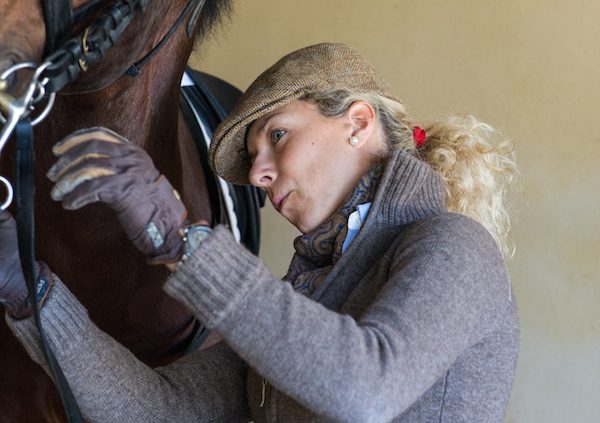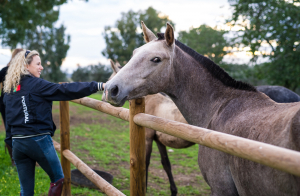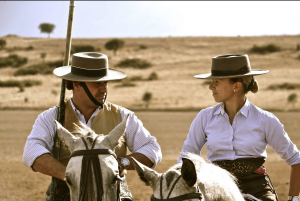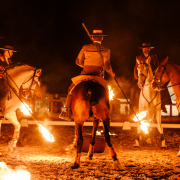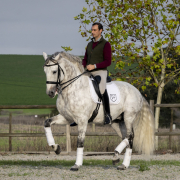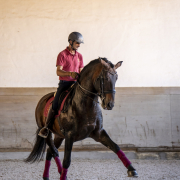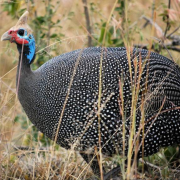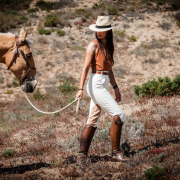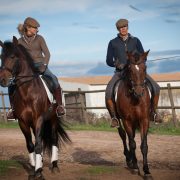Paulo & Maria Caetano Part 2
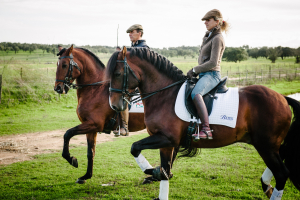
Maria Caetano – interview 2014
Maria is petite, pretty, intelligent and an extremely capable she rides Grand Prix dressage internationally and is not afraid to gallop across rolling hills rounding cattle. She is highly focussed and professional in her career never missing a day with the horses. I was really interested to learn how she developed her equine passion.
Maria you are doing just great in dressage competing Internationally and you were in the World Equestrian Games this year. We would love to know more about your life, your dreams and what it is like being trained by your famous dad. What age did you start riding?
I don’t remember the first time I sat on a horse. Since my first year I had been on a horse’s back with my dad. But I do remember that the first time I rode a horse by myself in the Golegã fair was at the age of 5.
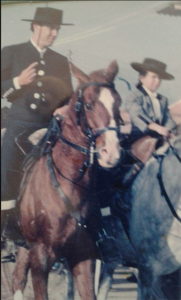
I started competing when I was 13 in small dressage competitions and the Portuguese traditional equitation competitions. But it was in the Working Equitation that I started the serous competition, I was 14 years old.
Do you have any funny stories of your early days riding? Did you and your brother get on or did you compete with each other?
I always had a big passion for bullfighting and riding out in the fields with cows. So, since I was very young (10 or 11) I used to bullfight small cows with my brother in the fields. I always did it and still do it just for fun. In 1999 when I was 13 years old I did perform 2 real public bullfights. However, despite my public presentation, it was never in my mind to be a professional bullfighter. I always wanted to follow a sport career.
You did very well in your younger years but you then competed on a warmblood how was that for you? Would you like to ride warmbloods now?
I started in the serious dressage competition as Junior. It was when I was in the young riders level that I started my steps into International competition. I chose to compete on warm bloods at that level because, at the time, they were more competitive in movements required for Prix St Georges. So, I competed as YR on White Cedar, a Hannoverian, and we achieved 2 gold medals in the National Championships and we competed 3 times in the European Championships. Then I needed a schoolmaster to help me to get in the Grand Prix and we bought Diamant, a big warmblood from Kasselman stables. He was a great schoolmaster for GP and gave me a gold medal in the Senior National Championships on 2008 and a place on the national team for the European Championships in Windsor 2009.
For me the good horses are the good ones, whatever their breed. However it’s a greater pleasure for me to represent my country on the back of a Lusitano.
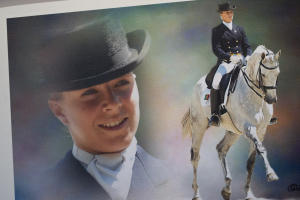
What makes the lusitanos special for you?
What makes the Lusitanos special is the willingness to work and to please the rider. A Lusitano is always trying to understand and help their rider, giving all of him or even more if he can.
You and your father have quite a dynamic relationship how do you like working together?
It’s a big pleasure, a lucky situation, to have my father as a trainer. We work every day together, which is a big advantage. Our relationship is spectacular. He can be strict, but we know that at the end of the day we are father and daughter! I’m so lucky to have a master like him at home!
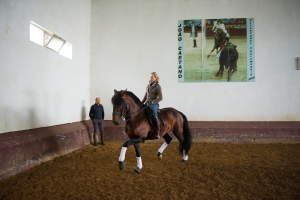
Is all your training with Paulo or do you have others trainers also? Attend clinics etc?
I have had the opportunity to learn from great masters. I spent some of my summer and Christmas holidays in Germany, training with Lisa Wilcox and then with Dolf Keller. I also use to attend to clinics with Kyra Kyrklund and her husband Richard White, Jan Bemelmans and Francisco Cancela de Abreu.
I have seen you and Paulo ride the same horse and I notice differences as would be with any two riders of course but i feel to get on a horse after Paulo has been riding must be quite a feel as he rides very much more classically and has the bull fighting roots. The horses seem very positively dynamic after him I would like to hear you thoughts and comments on the differences for you.
In fact we have the habit of sharing the horses’ daily work with each other. I find that it is very positive that we both ride the same horse since we can share feelings and opinions and then, we can direct the work in a best way. Of course my father has much more experience than me in training horses up to GP. So, he uses his skills, focus and his method in teaching the horses new exercises and I usually focus my method and skills on preparing them for the competitions.
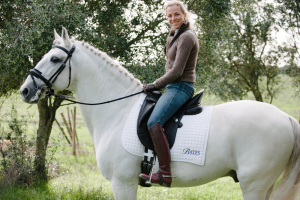
Maria on Xiripiti
Your riding has come from classical principles too how do you find the cross over into modern competition what are the key differences for you if any?
The classical equitation is, for me, the right basis for the sport. Also I always have present in my mind the FEI training scale, I think these are the main tool structure for the horse and the rider combined with classical principles they can bring you and your horse to competition. Nowadays Dressage has developed a lot and the marks increased exponentially, in my opinion we are beginning a golden times of good equitation and I think that riders are coming more and more to the classical principles.
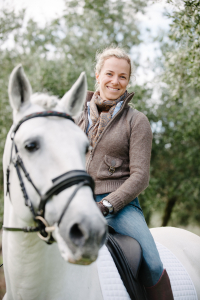 What was it like for you to ride out into the arena at the World Equestrian Games?
What was it like for you to ride out into the arena at the World Equestrian Games?
It was a big pleasure for me to represent my country with a Lusitano at the WEG! I had been before in 3 European Championships as Senior, but in the previous WEG (2010), my horse Util died 5 days before the competition, so I really wanted to be there this year. Unfortunately, Xiripiti was not totally fit, due to an injury he had after the National Championships, he lost some weeks of training before the WEG. Anyway, he did a very clear test, no mistakes, but without his usual strength in the extensions and half passes.
Maria, I guess your next goal is the Olympics and we would truly love to see you competing in them tell us a little about your ambitions we are very interested to know.
I prefer to be focused on the short term, since with horses you have to live day by day, developing your methods and your horse in the daily work and then the results in competition will appear. Anyway, of course that I have some goals in my sportive life, and one of them is the Olympics. Next year I will be focused on the European Championships that will take place in Aachen. A place for a long time now I’ve been dreaming to compete there. Then we will try to be in the Olympics. It’s a tough job to get a place in the Olympics as individual rider, so the first goal will be that the Portuguese team get placed into the 6 first team in the Europeans 2015 and consequently get the qualification, as a team, to the Olympics. I think that it is possible since we have a great group of horses and riders to compete next year in GP level. If it doesn’t happen, then I have to try to get a place as individual.
You told me that you are now very much involved in the horse breeding aspect of your farm how are you making your breeding decisions these days as I believe you are still producing Lusitanos for bull fighting and for dressage competition. How many mares do you have and do you use your own stallions?
We have 15 Lusitano mares we breed for dressage and for bullfight for a long time. I use to say, “when a horse is good is good for everything”. Of course it is not strictly like this but, we always try to find horses with strong backs and legs, with flexibility and “self-carry” and good mind, being always willing to work with the rider. These are essential characteristics for bullfighting and for dressage. Then, we try to use stallions with curriculum in dressage and in bullfighting.
Foals 6 months old
You are not just a dressage rider but a very fun adventurous rider that is not afraid to have some real fun galloping across the Alentejo hills rounding up cattle, and taking part in many Portuguese traditions wearing traditional clothing it is lovely to see this make you very cool in our eyes tell us a little about this side of your life.
I always loved to ride out in the countryside and to work with the cattle. I like to participate, as a hobby, in Acoso y Derribo competitions with my husband. It is a Spanish tradition where two riders have to lead a cow and catch it in the open field. It is really fun and it gives you a lot of adrenaline. We have to have very well trained horses to do it. I can’t imagine having a hobby without horses.
Maria and her ex husband in the fields
I want to thank you Paulo and Maria for your openness in revealing parts of your world, I think you have achieved remarkable things and are a truly inspirational family to know. Many top riders in Portugal are from classical schools of equitation such as The Portuguese School of Arte but very few have bull fighting as their training. What ever ones opinion is about bull fighting – it is an art of great precision and an outstanding horse/rider relationship it is also amazing to hear how a horse can compete PSG one day and bull fight the next. I very much look forward to following your future developments.
Thank you both x
Click here to read Part one with Paulo Caetano
Find Maria Caetano in Facebook
Find Paulo Caetano in Facebook
Text by Teresa Burton and Images by Lena Saugen Photography excluding vintages images.
